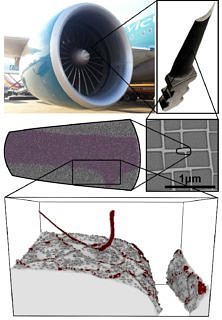The superpowers of superalloys
Materials scientists at FAU reconstruct turbine material atom by atom in computer simulations
Superalloys – materials made of a combination of nickel, aluminium and other elements such as rhenium – are essential for manufacturing turbine blades in jet engines, for example. They ensure that the turbines remain stable even at extremely high temperatures close to their melting point – crucial under the immense strain caused by centrifugal force. For this reason, materials scientists are constantly working on making superalloys even better. A team of researchers at FAU led by Prof. Dr. Erik Bitzek has now succeeded in reconstructing the atomic structure of a nickel-based superalloy so exactly using computer simulations that the simulations are able to reproduce and explain the actual deformation process in the real material structure. Until now, researchers have only ever been able to work with idealised structures in their simulations.
The Erlangen-based researchers are now able to accurately simulate how certain linear crystallographic defects (known as dislocations) in the nickel-based superalloy move when forces are exerted on the turbine blade, causing deformation of the material. In order to achieve this, Prof. Bitzek and his team began by using data gathered by their colleagues at the Max Planck Institute for Iron Research using an atom probe. Measurements taken using an atom probe provide 3D information about the atomic structure of an alloy but are only able to localise around two thirds of the atoms present.
However, the researchers were able to use the data collected in this way with a new software called nanoSCULPT, developed at their institute, to create atomic models that simulate not only the exact nature of the precipitates – particles with a different crystallographic structure and composition that are embedded in the crystal – but also the nickel and aluminium atoms in the alloy.
This allowed them to correctly simulate the precipitates around existing networks of dislocations and to accurately reproduce the dislocation structures that a team led by fellow FAU researcher Prof. Dr. Erdmann Spiecker had previously observed using a high-resolution transmission electron microscope. Prof. Bitzek and his team then used high performance computers at FAU to simulate tensile tests on these microstructures, which are made up of over 14 million atoms. This meant that, for the first time, they were able to show in detail on the atomic scale how the precipitates and the surrounding network of dislocations restrict the movement of dislocations, increasing the strength of the material.
The findings could now be used as a basis for developing superalloys that can withstand even higher temperatures, which would reduce the fuel consumption – and therefore the CO2 emissions – of jet engines. A total of nine groups of materials scientists at FAU are working towards this goal in collaboration with colleagues at Ruhr-Universität Bochum and other research institutions as part of the Collaborative Research Centre/Transregio 103 ‘From atom to turbine blade’ which, it was recently announced, is being funded by the German Research Foundation (DFG) for a further four years with 15 millions euros.
The FAU team’s results were published in a study in the journal Acta Materialia which is now one of the top ten most-read articles. The study was also mentioned in the latest bulletin of the Materials Research Society. A video of the simulations is available at http://bit.do/superalloy.
Further information:
Prof. Dr. Erik Bitzek
Phone: +49 9131 8527507
erik.bitzek@fau.de
